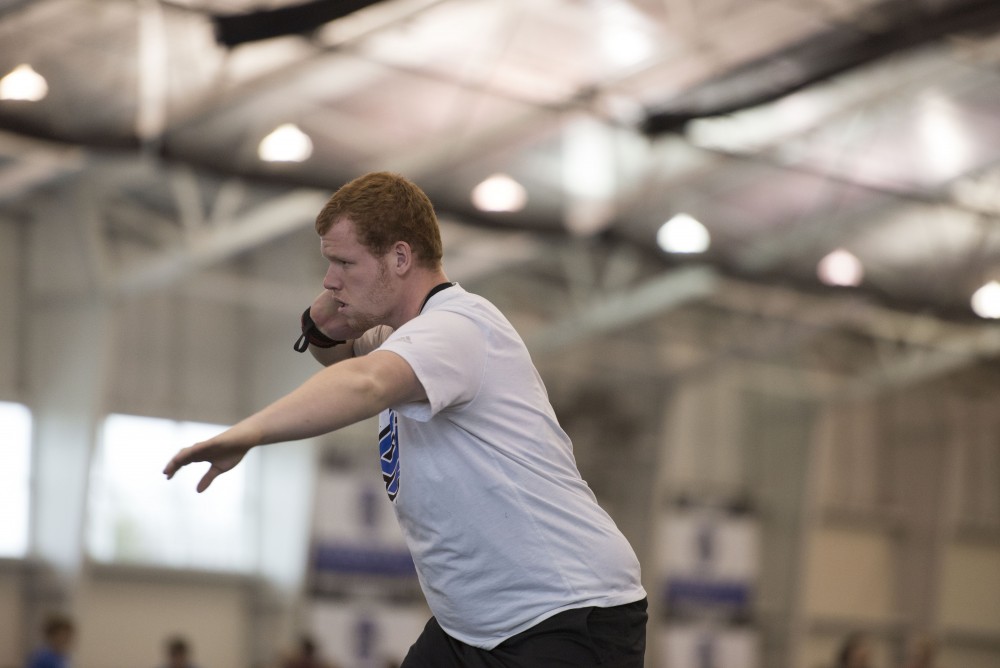GVSU track and field throwers “trusting in the process”

GVL / Luke Holmes – Mike Prestigiacomo gets ready to throw. The GVSU Lints Alumni Meet was held in the Kelly Family Sports Center on Saturday, Jan. 29, 2016.
Feb 2, 2017
An unbeatable distance runner or flashy sprinter usually steals the headlines, but behind the scenes the throwers have scored key points at big meets for the Grand Valley State track and field program.
The GVSU team is rich with history. Since 2000, the men’s and women’s sides have claimed the GLIAC crown a combined 63 times and the women have added four national championships.
Consistency in all areas of the team has been essential to the elongated period of success spanning almost two decades. One such faction of the team that has exemplified consistency with precision is the group of throwers.
Since GVSU’s track and field dominance began in 2000, the throwers have earned 99 All-American awards and 14 individual national titles.
During the indoor season the throwing events are limited to the weight throw and the shot put, but when outdoor rolls around, the athletes can choose from the hammer throw, the shot put, the javelin and the discus.
The year 2016 ended with a bang as Darien Thornton claimed the men’s weight throw national title and a berth at the Olympic Trials, but Thornton has graduated and others must now lead the program. Carrying the torch into 2017 are veterans Chris Saikalis, Mike Moon, Kyra Hull, Kaylyn Hill and Dajsha Avery.
The key to keeping the success rolling is to “trust the process.”
“A lot of the time freshmen will come in and they won’t really understand college throwing,” Moon said. “They’ll have a high school coach and they think their high school coach knows everything. It takes them a long time to get used to the college idea. Every thrower that comes in doesn’t see success right away. They have to trust the process.”
That same message has been preached to incoming GVSU throwers for years and the tradition is very much alive, the veterans said.
The most recent successes of the throwers can be credited to the progressive training style of third-year coach Sean Denard.
“My training revolves around technique and nervous system manipulation,” Denard said. “My goal is to teach the athlete how to practice at such a level that their nervous system takes over and causes chemical and mechanical reactions that improve competition results. The more consistent the athlete, the more correct our predictions for peaks and valleys of training can be.”
He puts each days’ activities into a log. The log includes everything from how lifting went, to how throwing went, to how the athletes felt during those activities. Using the log, he can look at charts showing when his athletes are peaking and when they will be at their best in the future in order to maximize performance.
“He matches it up during competitions so we can peak during meets,” Hill said. “It’s really beneficial to be able to know when your body is going to be operating at its best and to be able to have that land on a meet when you need to hit a good mark.”
Denard’s training is also consistent and intentional. Everything is a routine and organized to a tee, Hill said.
“It helps us work really hard,” Saikalis said. “We have to be disciplined to come in every day and work hard. The good thing is, we know if we do that we’ll be successful in the long run.”
Denard also encourages a tight-knit family atmosphere, a tradition that has been in the team for many years.
“We have ups and downs as throwers,” Avery said. “Having people around you that know what you’re going through, and that know different aspects of advice they can give you to help you further along, definitely makes a difference.”
The throwers are well-aware that their collegiate careers would have gone much differently if they weren’t a part of the family-like culture surrounding the team.
“If I didn’t have that, I definitely wouldn’t be as driven and it wouldn’t be as fun,” Moon said. “Training by yourself in the summer time is not fun. It’s hard to get out there and do it and to actually want to be there. Having a team and having everybody together doing the same thing, with the same goals, helps a lot.”
The tight-knit feeling of the throwers extends to the rest of the GVSU team as well. Add that to the high level of talent and the Lakers have their eyes on a national championship.
“That would mean more than anything else, more than any individual title would mean,” Saikalis said. “It’s the ultimate goal that everyone wants. Having that opportunity would be really amazing and something I could carry along for the rest of my life, something I’d be really proud of.”























